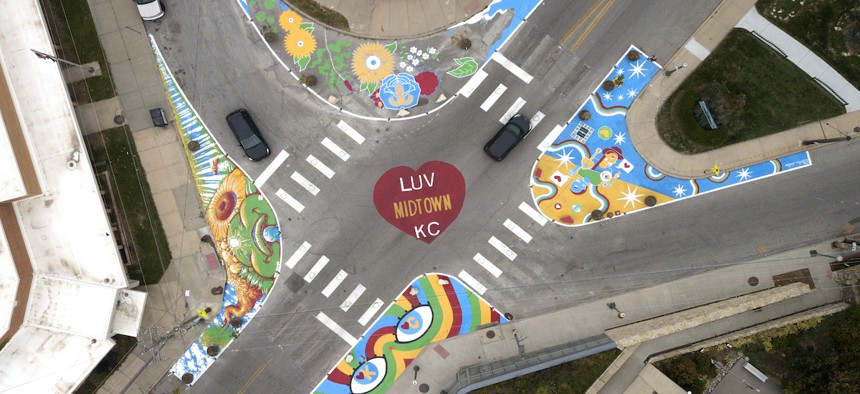An Initiative to Improve Street Safety through Public Art

The four-way intersection is buffeted by four curb expansions featuring murals, which shorten crosswalks and reshape the streets. Courtesy Bloomberg Philanthropies
Officials used street murals and planters to transform a hazardous intersection in Kansas City, Missouri, tapping grant funding from Bloomberg Philanthropies' Asphalt Art Initiative.
In the Westport neighborhood in Kansas City, Missouri, where Wyandotte Street meets Westport Road, something seemed to be missing.
The intersection, surrounded by a library, a church, a post office and a kitchen supply store, had charm, but lacked safety. Two streets had stop signs, but the intersection’s width and configuration still posed a hazard for residents trying to cross the street on foot, said DuRon Netsell, a Westport resident and head of the Kansas City-based urban design firm Street Smarts Design + Build.
“We had constant speeding, and it’s a really wide road, so pedestrians had to travel quite a long way to get to the other side,” he said. “I don’t think I’d ever seen a car yield properly to a pedestrian, even though there were crosswalks and yield signs. The traffic just moved too fast.”
Netsell thought the intersection had ample space for public art installations mixed with innovative safety upgrades, including wider curbs, plants and dedicated parking for bikes and scooters. But he wasn’t sure how to pay for the project. And then he heard about the Asphalt Art Initiative, a grant program from Bloomberg Philanthropies.
The program, currently accepting applications for its second round of grants, provides up to $25,000 for projects in U.S. cities that use art and design “to improve street safety, revitalize public spaces, and engage residents.” Up to 20 winners will be announced this fall, which officials said is key timing for cities that are beginning to reimagine the appearance—and importance—of public spaces in the wake of the coronavirus pandemic.
“By bringing light, color and creativity to blacktop, asphalt art projects can bring people together after so much time apart and breathe new life into our cities and our streets,” Janette Sadik-Khan, principal for transportation at Bloomberg Associates, said in a statement. “From open streets to outdoor dining, this past year has made the importance of the public realm clearer than ever, and this program will help cities coast to coast make their streetscapes as vibrant as the communities that come together to create them.”
Sixteen cities received grants for projects in 2020, including Kansas City, where Netsell worked with city officials and local artists to revamp the busy intersection in his neighborhood.
The project included a host of changes, including the addition of two more stop signs and four curb extensions—open spaces with boundaries marked by boulders and planters, instead of solid slabs of concrete. Each extension encompasses roughly 400 square feet of asphalt, which the city turned over to four local artists to use as a canvas. The motifs of each street mural are different—two graphic, two floral, with varied designs—but they’re connected through their use of color, Netsell said.
“The paint we used—it’s just traffic striping paint—only came in six colors,” he said. “It was really neat to see how that worked, because the artists all have different styles and visions and techniques, but they all have some cohesiveness because of that color palette.”
The transformation goes beyond aesthetics. The new intersection reduced overall vehicle speeds by 45%, shortened pedestrian crossing distances by half and reduced noise levels by 10 to 12 decibels, according to survey data from the city.
Adding the two stop signs was a significant factor in those results, Netsell said, but the curb extensions helped, too—by reshaping the intersection, shortening the crosswalks and making it harder for cars to speed around the corners.
“Whether it’s the art alone, or the stop signs alone, there’s a safety benefit, but combining the two is when the impact is fully realized," Netsell added. "They work tremendously well together.”
All U.S. cities are eligible to apply for the grants this year, including places that won funding last year, provided the money goes toward a new project. Netsell said he’d likely apply again, aiming to complete similar installations in other intersections throughout Kansas City.
“Right now, having art and fun and creativity in our neighborhoods and communities is such a wonderful thing we can bond over and see, just walking down the road,” he said. “When the art comes in, you know somebody really does care about this area.”
Kate Elizabeth Queram is a staff correspondent for Route Fifty and is based in Washington, D.C.
NEXT STORY: Rhode Island launches cloud-based job platform





